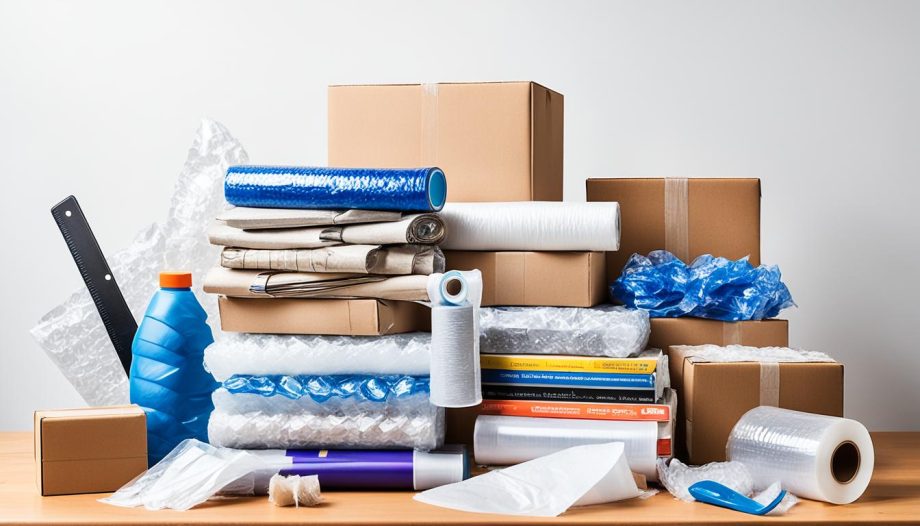Welcome to our comprehensive guide on how to pack your books for a move. Moving can be a stressful time, and ensuring the safety of your treasured books is essential. Our step-by-step process will provide you with helpful tips and techniques to protect your books during transit. With our expert advice, you can have peace of mind knowing that your beloved books will arrive at your new home in perfect condition.
Gather Packing Supplies
Before you start packing your books, it’s essential to gather all the necessary packing supplies. Having the right materials on hand will ensure the safe and secure transportation of your precious books. Here are the essential packing supplies you’ll need:
- Sturdy Cardboard Boxes: Look for durable boxes that are specifically designed for moving. These boxes should be able to withstand the weight of your books without collapsing or tearing.
- Packing Tape: Make sure to have enough packing tape to seal your boxes securely. Choose a high-quality tape that adheres well and won’t easily peel off during transit.
- Bubble Wrap: Bubble wrap provides excellent cushioning and protection for your books. Wrap fragile or valuable books individually with bubble wrap to prevent any damage or shifting during the move.
- Packing Paper: Use packing paper to fill empty spaces in the boxes and provide additional padding. It helps to prevent books from moving around inside the boxes and minimizes the risk of any potential damage.
Having these packing supplies readily available will make the packing process smoother and more efficient. It’s advisable to gather more supplies than you think you’ll need to ensure you have more than enough on hand.
Remember, packing your books using the proper materials is key to protecting them during the move. The next section will provide insights on how to sort and declutter your book collection before packing.
Note: The image shows a visual representation of various packing supplies, including sturdy cardboard boxes, packing tape, bubble wrap, and packing paper. These supplies are essential for safely packing and transporting your books during a move.
Sort and Declutter Your Book Collection
When preparing to move, sorting and decluttering your book collection can make a significant difference in the weight and volume of your moving boxes. It’s a great opportunity to reassess your reading preferences and make space for new books in your new home.
To start, evaluate each book and determine its value to you. Consider factors such as sentimental attachment, relevance, and potential for future reads. Ask yourself, “Will I realistically read this book again? Does it hold significant emotional or intellectual value?” This process will help you decide which books to keep, donate, or sell.

For books you choose to keep, ensure they are in good condition and align with your current interests. Removing books that no longer resonate with you creates an opportunity for others to enjoy them while freeing up space in your new home.
“By decluttering your book collection, you’re not just lightening your load physically, but also mentally. Letting go of what no longer serves you creates space for new experiences.”
If you decide to donate your books, consider local libraries, schools, or charitable organizations. Donating allows you to share the joy of reading with others while supporting the community. Additionally, selling books online or at local secondhand bookstores can help recoup some moving expenses.
Benefits of Sorting and Decluttering Your Book Collection:
- Reduced weight and volume of moving boxes, making the process more manageable.
- Elimination of unnecessary clutter, creating a more organized and streamlined living space.
- Potential to generate funds by selling unwanted books.
- Opportunity to share the joy of reading through book donations.
- Enhanced decision-making skills and a deeper understanding of personal reading preferences.
Sorting and decluttering your book collection before moving not only saves you time and effort during the packing process but also allows you to create a curated collection of books that truly reflect your interests and passions. It’s a chance to embark on your new chapter with a refreshed and purposeful book collection.
Organize Books by Size and Category
Properly organizing your books before packing is vital to ensure a secure fit inside your moving boxes. Categorizing them based on size, subject, or any method that works for you will make the packing and unpacking process much smoother.
Start by assessing your book collection and determining how you want to categorize them. You can organize them by genre, author, or even alphabetical order. This will help you locate specific books easily once you’ve reached your new home.
If you have limited space in your new place, consider prioritizing your books based on your preferences, keeping your favorite genres or authors easily accessible.
Organizing by Size
When packing your books, it’s essential to consider their sizes. Larger, heavier books should be placed at the bottom of the box, providing a solid foundation for the rest of your collection. Smaller books can then be nestled on top, with the spines facing up to prevent damage during transit.
Alternatively, you can stack books of similar sizes together, securing them with packing paper or bubble wrap to prevent shifting.
Organizing by Category
Categorizing your books by subject or genre is another effective way to organize and pack your collection. By grouping books that belong together, you’ll be able to keep them organized and easily find what you’re looking for after the move.
“Organizing your books by category not only makes them easier to pack and unpack but also helps create a visually appealing library in your new home.” – Book Lovers Magazine
Consider using separate boxes for different categories and labeling them accordingly. This way, you’ll know exactly where to find specific books when you’re ready to unpack.

Summary
Organizing your books by size and category is essential for a successful and stress-free move. By ensuring a secure fit inside the moving boxes and keeping them organized, you’ll protect your precious book collection and make the unpacking process more efficient.
| Benefits of Organizing Books | Tips for Organizing Books |
|---|---|
|
|
|
|
|
|
By implementing these organizing techniques, your book collection will remain safe and easily accessible throughout the moving process.
Protect Books with Proper Packaging
Packing books in a way that provides adequate protection is crucial to safeguarding them from damage during a move. Whether you’re transporting a small personal library or a few treasured volumes, proper packaging ensures your books remain in pristine condition throughout the journey.
One of the first steps to protect your books is choosing the right materials. Utilizing packing paper or bubble wrap, you can create a protective layer around each book. Start by wrapping the book with packing paper or bubble wrap, paying extra attention to the corners and edges, as they are more susceptible to damage. This additional layer provides a cushioning effect, mitigating the risk of impacts during transportation.
When placing books in boxes, it’s important to utilize a snug fit to prevent them from shifting during transit. Begin by selecting sturdy, cardboard boxes that can support the weight of your books. Line the bottom of the box with packing paper or bubble wrap to add extra cushioning.
“Proper packaging is essential to ensure your books arrive at their destination undamaged.”
For ease of unpacking and organizing, consider packing books in small to medium-sized boxes. This not only helps with weight distribution but also minimizes the risk of the boxes becoming overly heavy and difficult to handle.
While packing the books, place them in an upright position, similar to how they would be on a shelf. This prevents any unnecessary strain on the spines and ensures books maintain their shape. Alternatively, you can also stack books horizontally, but avoid overpacking the boxes as it can lead to excessive pressure on the lower books.
Creating layers of packing paper or bubble wrap between each row of books provides additional stability and protection. This prevents direct contact between the books, minimizing the risk of friction and potential damage.
Once the books are securely packed in the boxes, fill any remaining gaps with packing paper or bubble wrap to prevent shifting during the move. This extra layer of padding ensures the books stay in place and reduces the chances of them getting jostled or damaged.
Lastly, seal the boxes with high-quality packing tape to keep them secure. Label the boxes clearly with “Books” and indicate whether they are fragile or require special handling.
By following these proper packaging techniques, you can protect your books and ensure they arrive safely at your new destination. Taking the time to protect your beloved books during the moving process will allow you to continue enjoying them for years to come.
Label and Secure Boxes
Once your books are packed, it’s crucial to label each box correctly for easy identification during unpacking. A well-organized labeling system can save you time and effort when searching for specific books in your new home. Additionally, it’s important to secure the boxes properly to prevent any accidents or shifting during transit.
To label your boxes effectively, use a permanent marker to write a brief description on the top and sides of each box. Include the category or genre of books inside, such as “Fiction,” “Cooking,” or “Children’s Books.” This will make it easier for you to locate the desired boxes when setting up your new bookshelf.
When it comes to securing the boxes, packing tape is your best friend. Make sure to reinforce the bottom of each box with several layers of tape to prevent it from falling apart under the weight of your books. You can also use additional tape to secure the top flaps of the box for added protection.
If you’re concerned about your books shifting during transit, consider using packing paper or bubble wrap to fill any empty spaces inside the boxes. This will help keep your books snug and prevent them from moving around.
Pro Tip: When stacking the boxes in your moving vehicle, place heavier boxes on the bottom and lighter boxes on top. This will provide better structure and stability during transportation.
By labeling your boxes accurately and ensuring they are securely packed, you can have peace of mind knowing that your books will arrive safely at your new home. Taking these extra steps will make the unpacking process much smoother and enjoyable, allowing you to dive back into the world of books without any hassle.
Loading and Transporting Your Packed Books
Once you have successfully packed your books for the move, it’s time to focus on loading and transporting them safely to your new location. Follow these best practices to ensure a smooth moving process and keep your treasured books in excellent condition.
When loading the packed books onto a moving truck or vehicle, it’s crucial to arrange the boxes strategically. Start by placing the heavier and larger boxes at the bottom to provide a stable base. Then, stack the lighter and smaller boxes on top, ensuring they are secure and won’t shift during transit. This arrangement helps to maximize space and prevents potential damage to your books.
During transportation, make sure to handle your boxes with care. Avoid placing heavy items on top of the boxes containing books. Additionally, secure the boxes properly to prevent them from sliding or falling during the journey. Use straps or ropes to secure the load and provide further stability.
Once you reach your new home, remember to handle the boxes containing your books delicately. Be cautious while unloading and avoid dropping or mishandling them. By taking these precautions, you can ensure the safety of your packed books during the loading and transportation process.




